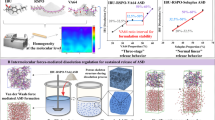ABSTRACT
Purpose
To investigate the effect of the manufacturing method (spray-drying or hot-melt extrusion) on the kinetic miscibility of miconazole and the graft copolymer poly(ethyleneglycol-g-vinylalcohol). The effect of heat pre-treatment of solutions used for spray-drying and the use of spray-dried copolymer as excipient for hot-melt extrusion was investigated.
Method
The solid dispersions were prepared at different drug-polymer ratios and analyzed with modulated differential scanning calorimetry and X-ray powder diffraction.
Results
Miconazole either mixed with the PEG-fraction of the copolymer or crystallized in the same or a different polymorph as the starting material. The kinetic miscibility was higher for the solid dispersions obtained from solutions which were pre-heated compared to those spray-dried from solutions at ambient temperature. Hot-melt extrusion resulted in an even higher mixing capability. Here the use of the spray-dried copolymer did not show any benefit concerning the kinetic miscibility of the drug and copolymer, but it resulted in a remarkable decrease in the torque experienced by the extruder allowing extrusion at lower temperature and torque.
Conclusion
The manufacturing method has an influence on the mixing capacity and phase behavior of solid dispersions. Heat pre-treatment of the solutions before spray-drying can result in a higher kinetic miscibility. Amorphization of the copolymer by spray-drying before using it as an excipient for hot-melt extrusion can be a manufacturing benefit.









Similar content being viewed by others
REFERENCES
Janssens S, Van den Mooter G. Review: physical chemistry of solid dispersions. J Pharm Pharmacol. 2009;61:1571–86.
Leuner C, Dressman J. Improving drug solubility for oral delivery using solid dispersions. Eur J Pharm Biopharm. 2000;50:47–60.
Vasconcelos T, Sarmento B, Costa P. Solid dispersions as strategy to improve oral bioavailability of poor water soluble drugs. Drug Discov Today. 2007;12:1068–75.
Janssens S, Denivelle S, Rombaut P, Van den Mooter G. Influence of polyethylene glycol chain length on compatibility and release characteristics of ternary solid dispersions of itraconazole in polyethylene glycol/hydroxypropylmethylcellulose 2910 E5 blends. Eur J Pharm Sci. 2008;35(3):203–2010.
Janssens S, de Armas HN, Roberts CJ, Van den Mooter G. Characterization of ternary solid dispersions of itraconazole, PEG 6000 and HPMC 2910 E5. J Pharm Sci. 2008;97(6):2110–20.
Six K, Verreck G, Peeters J, Brewster M, Van den Mooter G. Increased physical stability and improved dissolution properties of itraconazole, a class II drug, by solid dispersions that combine fast-and slow dissolving polymers. J Pharm Sci. 2004;93(1):124–31.
Janssens S, Novoa de Armas H, Remon JP, Van den Mooter G. The use of a new hydrophilic polymer, Kollicoat IR®, in the formulation of solid dispersions of itraconazole. Eur J Pharm Sci. 2007;30:288–94.
Janssens S, Anné M, Rombaut P, Van den Mooter G. Spray-drying from complex solvent systems broadens the applicability of Kollicoat IR as a carrier in the formulation of solid dispersions. Eur J Pharm Sci. 2009;37:241–8.
Guns S, Kayaert P, Martens JA, Van Humbeeck J, Mathot V, Pijpers T, et al. Characterization of the copolymer poly(ethyleneglycol-g-vinylalcohol) as a potential carrier in the formulation of solid dispersions. Eur J Pharm Biopharm. 2010;74(2):239–47.
Six K, Verreck G, Peeters J, Augustijns P, Kinget R, Van den Mooter G. Characterization of glassy itraconazole: a comparative study of its molecular mobility below T(g) with that of structural analogues using MTDSC. Int J Pharm. 2001;213:163–73.
Yu L. Inferring thermodynamic stability relationship of polymorphs from melting data. J Pharm Sci. 1995;84:966–74.
ACKNOWLEDGMENTS
SG and PK acknowledge the Agency for Innovation by Science and Technology in Flanders (IWT) for a Ph.D grant. The authors acknowledge financial support from FWO-Vlaanderen.
Author information
Authors and Affiliations
Corresponding author
Rights and permissions
About this article
Cite this article
Guns, S., Dereymaker, A., Kayaert, P. et al. Comparison Between Hot-Melt Extrusion and Spray-Drying for Manufacturing Solid Dispersions of the Graft Copolymer of Ethylene Glycol and Vinylalcohol. Pharm Res 28, 673–682 (2011). https://doi.org/10.1007/s11095-010-0324-2
Received:
Accepted:
Published:
Issue Date:
DOI: https://doi.org/10.1007/s11095-010-0324-2




